May 20, 2025 | 17:00 GMT +7
May 20, 2025 | 17:00 GMT +7
Hotline: 0913.378.918
May 20, 2025 | 17:00 GMT +7
Hotline: 0913.378.918
Khanh Son is a mountainous district of Khanh Hoa province, about 100km southwest of Nha Trang city centre. Due to its location in the transition zone between the Lam Dong plateau and the Central Coast, the climate in Khanh Son is characterized by tropical monsoon and temperate climate.
In addition, the soil here is characterized by basalt red soil accounting for over 71%, Alluvial soil accounts for nearly 5%, pH from 5 - 6, and fairly fertile. Along with that, the intermediate minerals are available in the soil, so it is very suitable for growing many fruit trees such as durian, mangosteen, rambutan, and green-skinned pomelo.
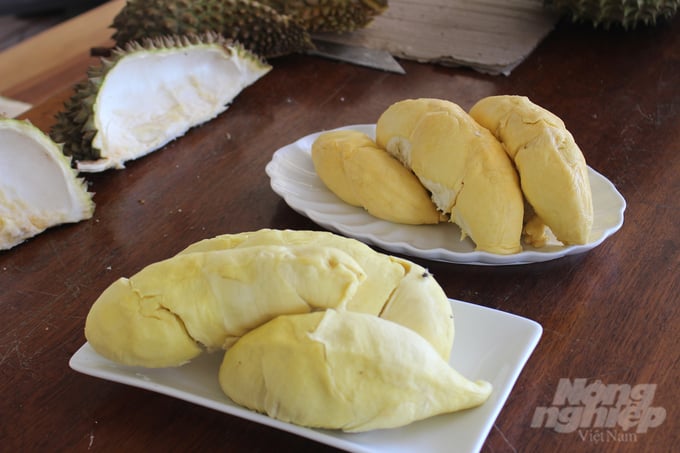
Khanh Son durian has a large, fragrant, sweet taste, yellow rice, and flat seeds. Photo: Kim So
In particular, the Monthong-like durian tree is grown in Khanh Son for high yield and quality, with an average weight of 4-5kg/fruit. In particular, many fruits are reaching 7 - 8kg. According to consumers and traders, Khanh Son durian is much tastier than durian in many other regions. Not only does the durian have large segments and, an aromatic, sweet taste but it also has yellow fresh, flat seeds, a flesh weight ratio of up to 30-40%/fruit.
Mr Do Nhi Huy, Head of the Agriculture and Rural Development Department of Khanh Son district, said that Khanh Son durian has excellent quality. It has been certified by the National Office of Intellectual Property to own the brand of flat-grain yellow fresh since March 2011. The reason the durian here has outstanding quality is because the temperature difference between day and night is high (8 - 9 degrees Celsius). This is a condition that helps the accumulation of dry matter in durian fruit to be enhanced.
On the other hand, Khanh Son durian has the advantage of flowering and ripening "out of phase" with other places, so there is no competition or conflict in the consumption market. According to farmers in Khanh Son district, the durian season here starts harvesting around July every year and ends at the end of August. That means Khanh Son durian is harvested about 1-2 months later than durian in the West and Southeast and 1 month earlier than durian in the Central Highlands. Therefore, when it comes to the harvest season, traders from different regions flock to buy durian and sell it everywhere.
Previously, Khanh Son durian was grown by a local person from durian seeds. Unexpectedly, the durian tree grew and developed well. In 1999, after studying climate factors, local soil quality and characteristics of durian trees, Khanh Son district contacted the Southern Horticultural Research Institute to bring durian varieties such as Ri6, Chin Hoa, and Monthong to trial production in an area of about 10 ha.
To date, the area of Khanh Son durian has reached about 2,500 ha, mainly containing the Monthong variety and a few other varieties like Chin Hoa and Ri6. Of these, about 1,200 ha are currently in business, with an output of 15,000 tons.
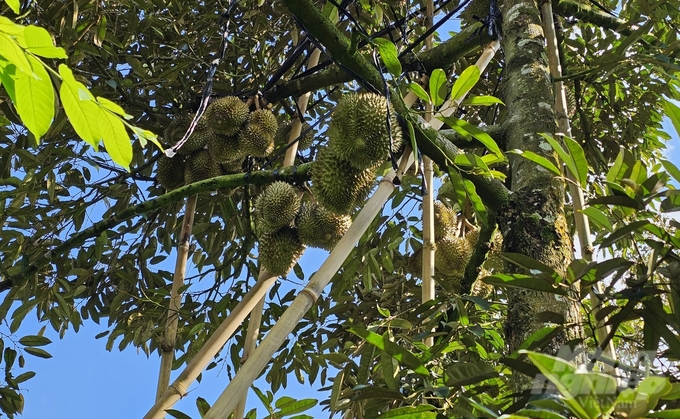
Khanh Son Durian has the advantage of flowering and fruiting "out of phase" with other places, so it is not competitive in the consumer market. Photo: Kim So
By 2008, Khanh Son district supported seeds, supplies, and fertilizers for farmers with an area of nearly 500 ha, mainly ethnic minorities. In addition, Khanh Hoa province has a policy to support crop conversion, supporting 50% of the costs of seeds, fertilizers, and irrigation systems for households converting inefficient cultivars to durian.
In the last days of August, people in Khanh Son district are busy harvesting durian for the last time. This year, the second lunar month leaps, along with the unusual weather, so Khanh Son durian blooms twice and later than usual.
Before that, in late June - early July, a few areas of early ripening durian in the western communes of this district including Son Lam, Thanh Son, and Son Binh were harvested and sold at an average price of VND 50,000 - 60,000/kg. By early August, the main crop of durians begins to enter full harvest.

Mr. Luong Thanh Son's durian garden has an area of 0.8ha, this year's profit is nearly VND 600 million. Photo: Kim So
However, according to farmers, about 2 weeks before the harvest time, the Khanh Son durian area was bustling. Traders from everywhere, including Chinese traders, flocked to the durian gardens in the area and placed large deposits to buy, pushing up durian prices.
Mr Luong Thanh Son, a durian grower in Hap Thinh residential group, To Hap town (Khanh Son district), said that in no year have Khanh Son durian growers been as content as this year when the output and selling price set a historic peak.
Accordingly, depending on whether the durian garden produces good or bad fruit, traders deposit to buy buckets at different prices. Averaging about VND 55,000 /kg for Ri6 durian and from VND 70,000 - 80,000/kg for Monthong durian. While every year Ri6 durian only ranges from VND 35,000 - 42,000/kg, last year's Monthong highest price only ranges from VND 52,000 - 53,000/kg.

Khanh Son durian is being harvested at the end of the season, but the price of durian purchased in buckets remains stable at VND 70 - 80 thousand/kg. Photo: Kim So
The purchase price of durian this year is the highest ever, according to farmers. That's because many durian growing areas in Khanh Son now have area codes, so traders, even including Chinese traders flocking in to buy, fix prices and wait for the harvest date to officially export to the Chinese market.
Currently, Khanh Son durian is being harvested at the end of the season, but according to records, the price of durian purchased in buckets remains stable from VND 70,000 to 80,000/kg for the Mongthong variety (depending on the garden). Mr. Nguyen Quoc Dong, Vice Chairman of the Khanh Son District People's Committee said, this is a bumper durian crop for the Khanh Son people. The district's agricultural sector estimates that revenue from durian this year will be about VND 1,000 billion.
Translated by Hoang Duy
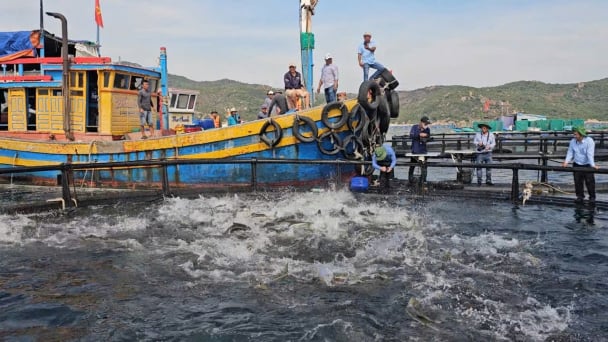
(VAN) Khanh Hoa is investing over 545 billion VND to develop 240 hectares of high-tech marine aquaculture in order to guarantee a consistent supply of seafood exports and achieve the USD 1 billion target.

(VAN) Minister of Agriculture and Environment Do Duc Duy held a meeting with Soopakij Chearavanont, Chairman of C.P. Group, on May 15.
/2025/05/16/3800-0-nongnghiep-143756.jpg)
(VAN) Suntory PepsiCo Vietnam coordinated with the Ministry of Education and Training to implement an education program on water conservation, reaching nearly 1 million primary school students nationwide.
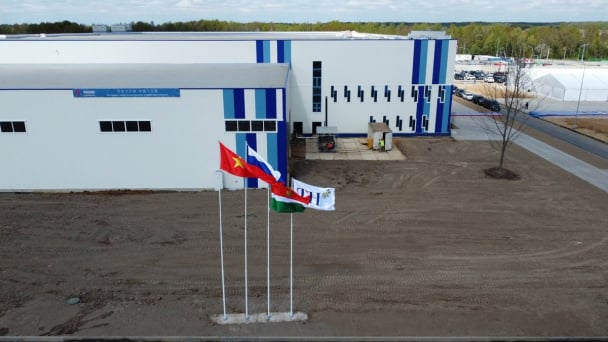
(VAN) Vietnam’s TH Group officially put its high-tech fresh milk processing plant into operation in the Russian Federation, marking a historic moment as the first TH true MILK cartons were produced in Russia.

(VAN) Use of high-quality broodstock and biotechnology is regarded as the most effective approach to ensuring sustainable and economically viable shrimp aquaculture ahead of climate change and the emergence of increasingly intricate disease patterns.
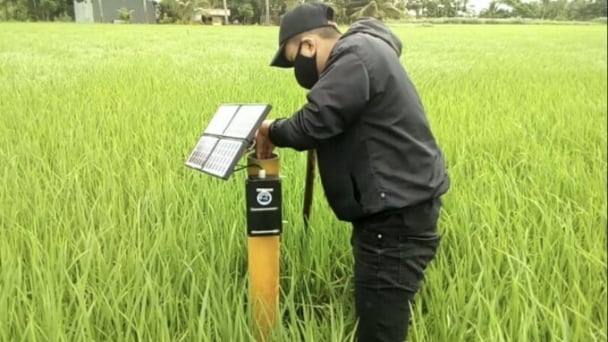
(VAN) Carbon farming is a form of agricultural practices that helps absorb more greenhouse gases than it emits, through smart management of soil, crops, and livestock.
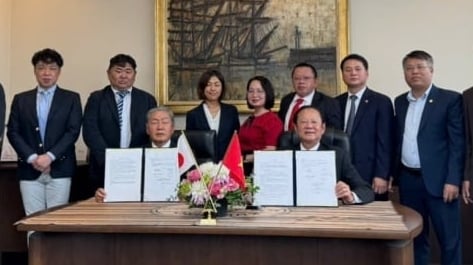
(VAN) This is a key content of the Memorandum of Understanding recently signed between the Vietnam Fisheries Society and Kunihiro Inc of Japan.